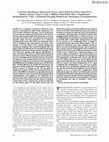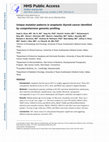Papers by Barbara Burtness
Cancer
In a small cohort of human immunodeficiency virus–related head and neck cancers, the majority are... more In a small cohort of human immunodeficiency virus–related head and neck cancers, the majority are demonstrated to bear mutations in head and neck cancer–relevant genes, with some similarities to genomic profiles for human immunodeficiency virus–unrelated head and neck cancers. Although gene panels are not definitive for mutational signatures, the pattern of mutations is consistent with mutational signatures associated with the activity of the virally responsive APOBEC gene editing proteins.See also pages 84‐94.

Head & neck, Feb 2, 2012
Background-To determine whether the incidence of bilateral neck disease tonsil cancer is rising. ... more Background-To determine whether the incidence of bilateral neck disease tonsil cancer is rising. Methods-We reviewed tonsil cancer incidence data from the Surveillance, Epidemiology and End Results (SEER) Program of the National Cancer Institute. Results-The annual incidence of advanced neck disease (≥N2) with small primary tonsil cancer is increasing (annual percent change (APC), p < 0.05) during two evaluable time frames (1988-2003 and 2004-2008). The increase for small primary tonsil cancer from 2004-2008 is associated with increased ipsilateral disease (ie, T1-2N2ab, APC 10.6%, p < 0.05) rather than bilateral neck disease (T1-2N2c, APC 5.9%, APC = NS). The increase in bilateral neck disease is less than the overall rise in T1-2 tonsil cancer (APC 7.2%, p < 0.05). Conclusions-In the HPV era bilateral neck disease is increasingly common. This appears to be a consequence of increasing incidence of tonsil cancer rather than a new biologic behavior.

Trials, Nov 29, 2014
Background: Over 50% of patients with head and neck squamous cell carcinoma (HNSCC) present with ... more Background: Over 50% of patients with head and neck squamous cell carcinoma (HNSCC) present with locoregionally advanced disease. Those at intermediate-to-high risk of recurrence after definitive therapy exhibit advanced disease based on tumour size or lymph node involvement, non-oropharynx primary sites, human papillomavirus (HPV)-negative oropharyngeal cancer, or HPV-positive oropharynx cancer with smoking history (>10-pack-years). Non-surgical approaches include concurrent chemoradiotherapy, induction chemotherapy followed by definitive radiotherapy or chemoradiotherapy, or radiotherapy alone. Following locoregional therapies (including surgical salvage of residual cervical nodes), no standard intervention exists. Overexpression of epidermal growth factor receptor (EGFR), an ErbB family member, is associated with poor prognosis in HNSCC. EGFR-targeted cetuximab is the only targeted therapy that impacts overall survival and is approved for HNSCC in the USA or Europe. However, resistance often occurs, and new approaches, such as targeting multiple ErbB family members, may be required. Afatinib, an irreversible ErbB family blocker, demonstrated antiproliferative activity in preclinical models and comparable clinical efficacy with cetuximab in a randomized phase II trial in recurrent or metastatic HNSCC. LUX-Head & Neck 2, a phase III study, will assess adjuvant afatinib versus placebo following chemoradiotherapy in primary unresected locoregionally advanced intermediate-to-high-risk HNSCC. Methods/design: Patients with primary unresected locoregionally advanced HNSCC, in good clinical condition with unfavourable risk of recurrence, and no evidence of disease after chemoradiotherapy will be randomized 2:1 to oral once-daily afatinib (40 mg starting dose) or placebo. As HPV status will not be determined for eligibility, unfavourable risk is defined as non-oropharynx primary site or oropharynx cancer in patients with a smoking history (>10 pack-years). Treatment will continue for 18 months or until recurrence or unacceptable adverse events occur. The primary endpoint measure is duration of disease-free survival; secondary endpoint measures are disease-free survival rate at 2 years, overall survival, health-related quality of life and safety.
Journal of Clinical Oncology, Apr 10, 2013
Written on behalf of the Eastern Cooperative Oncology Group.

Journal of the National Cancer Institute, Jun 26, 2023
Many multicenter randomized clinical trials in oncology are conducted through the National Clinic... more Many multicenter randomized clinical trials in oncology are conducted through the National Clinical Trials Network (NCTN), an organization consisting of 5 cooperative groups. These groups are made up of multidisciplinary investigators who work collaboratively to conduct trials that test novel therapies and establish best practice for cancer care. Unfortunately, disparities in clinical trial leadership are evident. To examine the current state of diversity, equity, and inclusion across the NCTN, an independent NCTN Task Force for Diversity in Gastrointestinal Oncology was established in 2021, the efforts of which serve as the platform for this commentary. The task force sought to assess existing data on demographics and policies across NCTN groups. Differences in infrastructure and policies were identified across groups as well as a general lack of data regarding the composition of group membership and leadership. In the context of growing momentum around diversity, equity, and inclusion in cancer research, the National Cancer Institute established the Equity and Inclusion Program, which is working to establish benchmark data regarding diversity of representation within the NCTN groups. Pending these data, additional efforts are recommended to address diversity within the NCTN, including standardizing membership, leadership, and publication processes; ensuring diversity of representation across scientific and steering committees; and providing mentorship and training opportunities for women and individuals from underrepresented groups. Intentional and focused efforts are necessary to ensure diversity in clinical trial leadership and to encourage design of trials that are inclusive and representative of the broad population of patients with cancer in the United States. Clinical trials are the cornerstone of cancer research, generating the highest level of evidence on the efficacy of procedural interventions and novel therapeutics to improve outcomes for patients with cancer. Results of clinical trials are disseminated among the oncology community through publications, presentations at conferences, and consensus guidelines; findings can be practice changing. Although the primary goal of a clinical trial is to benefit patients, trial design and conduct play an important role in career development for clinical investigators. A successfully conducted clinical trial may contribute to long-term

Oncotarget, May 24, 2022
Evolving understanding of head and neck squamous cell carcinoma (HNSCC) is leading to more specif... more Evolving understanding of head and neck squamous cell carcinoma (HNSCC) is leading to more specific diagnostic disease classifications. Among HNSCC caused by the human papilloma virus (HPV), tumors harboring defects in TRAF3 or CYLD are associated with improved clinical outcomes and maintenance of episomal HPV. TRAF3 and CYLD are negative regulators of NF-κB and inactivating mutations of either leads to NF-κB overactivity. Here, we developed and validated a gene expression classifier separating HPV+ HNSCCs based on NF-κB activity. As expected, the novel classifier is strongly enriched in NF-κB targets leading us to name it the NF-κB Activity Classifier (NAC). High NF-κB activity correlated with improved survival in two independent cohorts. Using NAC, tumors with high NF-κB activity but lacking defects in TRAF3 or CYLD were identified; thus, while TRAF3 or CYLD gene defects identify the majority of tumors with NF-κB activation, unknown mechanisms leading to NF-kB activity also exist. The NAC correctly classified the functional consequences of two novel CYLD missense mutations. Using a reporter assay, we tested these CYLD mutations revealing that their activity to inhibit NF-kB was equivalent to the wild-type protein. Future applications of the NF-κB Activity Classifier may be to identify HPV+ HNSCC patients with better or worse survival with implications for treatment strategies.

British Journal of Cancer, Oct 1, 1998
Seventy-one patients with poor-prognosis breast cancer were enrolled after informed consent in a ... more Seventy-one patients with poor-prognosis breast cancer were enrolled after informed consent in a multicentre randomized study to evaluate the use of selected peripheral blood CD34cells to support haematopoietic recovery following high-dose chemotherapy. Patients who responded to conventional chemotherapy were mobilized with chemotherapy (mainly high-dose cyclophosphamide) and/or recombinant human granulocyte colony-stimulating factor (rhG-CSF). Patients who reached the threshold of 20 CD34cells per (l of peripheral blood underwent apheresis and were randomized at that time to receive either unmanipulated mobilized blood cells or selected CD34-cells. For patients in the study arm, CD34cells were selected from aphereses using the lsolex®380 device. Fifteen patients failed to mobilize peripheral blood progenitors and nine other patients were excluded for various reasons. Forty-seven eligible patients were randomized into two comparable groups. CD34cells were selected from aphereses in the study group. Haematopoietic recovery occurred at similar times in both groups. No side-effect related to the infusion of selected cells was observed. The frequency of epithelial tumour cells in aphereses was low (8 out of 42 evaluated patients), as determined by immunocytochemistry. We conclude that selected CD34cells safely support haematopoietic recovery following high-dose chemotherapy in patients with poor-prognosis breast cancer.

Cancers of the Head & Neck, Dec 1, 2020
Background: We conducted a correlative study for E2399, a function preservation trial for resecta... more Background: We conducted a correlative study for E2399, a function preservation trial for resectable locally advanced oropharynx and larynx cancer, to prospectively assess effects of chemoradiation (CCR) on quality of life (QOL), swallowing and voice. We correlated the results of swallow assessments done via questionnaires and objective assessments by modified barium swallow (MBS). Methods: The Functional Assessment of Cancer-HN (FACT-HN), the Performance Status Scale-Head and Neck (PSS-HN), swallow assessments (including modified barium swallow studies), and voice assessments: Voice Handicap Index (VHI), the Voice Disability Assessment (VDA), and American Speech-Language Hearing Association's Functional Communication Measure (FCM) were conducted at baseline and periodically post-treatment for 2 years. Results: Baseline QOL and swallowing function predicted overall survival. Patients experienced a marked decrease in QOL, swallowing, and speech post CCR although the decrease in vocal function was modest. Function and QOL returned towards baseline in the majority of patients by 12 months post treatment. Less than 10% of patients had severe dysphagia and were PEG dependent at 12 months post treatment. There was a high degree of correlation between the FACT-HN and PSS-HN swallow items. Statistically significant correlations were found between subjective and objective measures of swallow function. Conclusions: Patients experience marked loss in swallowing function post CCR which returned to baseline in the majority of patients. The correlations between the FCM and self-report swallow items on the PSS and FACT-HN appear to be sufficiently strong to justify their use as a surrogate marker for swallowing disability in large therapeutic trials.

International Journal of Radiation Oncology Biology Physics, 2011
Purpose-Appropriate treatment of the lower neck when using IMRT is controversial. Our study tried... more Purpose-Appropriate treatment of the lower neck when using IMRT is controversial. Our study tried to determine differences in clinical outcomes using IMRT or a standard LNF to treat low neck. Methods and Materials-This is a retrospective, single institution study. Ninety-one patients with squamous cell carcinoma of head and neck cancer were treated with curative intent. Based on physician preference, some patients were treated with LNF (PTV3) field using a single anterior photon field matched to the IMRT field. Field junctions were not feathered. The endpoints were time to failure and use of PEG tube (as a surrogate of laryngeal edema causing aspiration) and analysis done with chi-square and the log-rank tests. Results-Median follow up 21 months (range 2-89). The median age 60 years. Thirty seven (41%) were treated with LNF, 84% were stage III or IV. PEG tube was required in 30% as opposed to 33% without the use of LNF. N2 or 3 neck disease was treated more commonly without a LNF (38% vs. 24%, p = 0.009). Failures occurred in 12 patients (13%). Only one patient treated with LNF failed regionally, 4.5 cm above the match line. The 3-year disease-free survival rate was 87%, 79% with LNF and without LNF respectively (p = 0.2) and the 3-year LR failure rate was 4%, 21% respectively, (p = 0.04). Conclusions-Using LNF to treat the low neck did not increase the risk of regional failure "in early T& early N diseases" or decrease PEG tube requirements.
Supplementary Data from Nuclear Localization of Signal Transducer and Activator of Transcription ... more Supplementary Data from Nuclear Localization of Signal Transducer and Activator of Transcription 3 in Head and Neck Squamous Cell Carcinoma Is Associated with a Better Prognosis
Supplementary Tables 1-4 from Detection of Tumor Epidermal Growth Factor Receptor Pathway Depende... more Supplementary Tables 1-4 from Detection of Tumor Epidermal Growth Factor Receptor Pathway Dependence by Serum Mass Spectrometry in Cancer Patients

Cancer, 2020
BackgroundThis study was designed to test the hypothesis that the effectiveness of intensive trea... more BackgroundThis study was designed to test the hypothesis that the effectiveness of intensive treatment for locoregionally advanced head and neck cancer (LAHNC) depends on the proportion of patients' overall event risk attributable to cancer.MethodsThis study analyzed 22,339 patients with LAHNC treated in 81 randomized trials testing altered fractionation (AFX; Meta‐Analysis of Radiotherapy in Squamous Cell Carcinomas of Head and Neck [MARCH] data set) or chemotherapy (Meta‐Analysis of Chemotherapy in Head and Neck Cancer [MACH‐NC] data set). Generalized competing event regression was applied to the control arms in MARCH, and patients were stratified by tertile according to the ω score, which quantified the relative hazard for cancer versus competing events. The classifier was externally validated on the MACH‐NC data set. The study tested for interactions between the ω score and treatment effects on overall survival (OS).ResultsFactors associated with a higher ω score were a youn...

Blood, 1998
Ad.CMV-CD is a replication incompetent adenoviral vector carrying a cytomegalovirus (CMV)-driven ... more Ad.CMV-CD is a replication incompetent adenoviral vector carrying a cytomegalovirus (CMV)-driven transcription unit of the cytosine deaminase (CD) gene. The CD transcription unit in this vector catalyzes the deamination of the nontoxic pro-drug, 5-fluorocytosine (5-FC), thus converting it to the cytotoxic drug 5-fluorouracil (5-FU). This adenoviral vector prodrug activation system has been proposed for use in selectively sensitizing breast cancer cells, which may contaminate collections of autologous stem cells products from breast cancer patients, to the toxic effects of 5-FC, without damaging the reconstitutive capability of the normal hematopoietic cells. This system could conceivably kill even the nondividing breast cancer cells, because the levels of 5-FU generated by this system are 10 to 30 times that associated with systemic administration of 5-FU. The incorporation of 5-FU into mRNA at these high levels is sufficient to disrupt mRNA processing and protein synthesis so that ...

Journal of Clinical Oncology, 2019
6020 Background: A subset of salivary gland cancer (SGCs) express the androgen receptor (AR). Thi... more 6020 Background: A subset of salivary gland cancer (SGCs) express the androgen receptor (AR). This phase II trial evaluated the anti-androgen enzalumatide (Astellas) for patients with AR+ SGCs. Methods: Locally advanced/unresectable or metastatic AR+ SGCs were enrolled (AR status was centrally confirmed). Prior therapy with AR-targeted drugs was allowed. Enzalutamide 160 mg orally once daily was given (1 cycle= 28 days). The primary endpoint was confirmed response (RR) according to RECIST v1.1 within the first 8 cycles. Secondary endpoints were progression-free survival (PFS), overall survival (OS), and safety. A Simon-Optimal two-stage design was used to detect a 20% RR (vs. 5%) (alpha = 5%; beta = 90%). > 1 response(s) in the first 21 would trigger accrual to 41; > 4 responses would be considered promising. Results: 46 eligible patients (pts) were enrolled (40 M, 6 F; median age 65) in 22 months. In the first 21 pts, we initially had 2 confirmed PRs allowing for full study a...

Head & Neck, 2019
IntroductionAnaplastic thyroid cancer (ATC) is a highly aggressive thyroid cancer. Those ATC with... more IntroductionAnaplastic thyroid cancer (ATC) is a highly aggressive thyroid cancer. Those ATC with genomic alterations (GAs) in TSC2, ALK, and BRAF may respond to targeted therapies.MethodsComprehensive genomic profiling on 90 ATC specimens identified base substitutions, short insertions and deletions, amplifications, copy number alterations, and genomic rearrangements in up to 315 cancer‐related genes and 28 genes commonly rearranged in cancer.ResultsMedian patient age was 65 (range, 33‐86) years, 50 patients were male. There was a mean of 4.2 GA per case, range 1‐11. The most common GA were TP53 (66%), BRAF (34%), TERT (32%), CDKN2A (32%), and NRAS (26%). BRAF V600E and NRAS/HRAS/KRAS alteration were mutually exclusive. BRAF, CDKN2A, PIK3CA, and JAK2 were more frequent in patients >70 years of age; while myc, PTEN, and NRAS were more common in those ≤50 years.ConclusionATC shows many GA with potential therapeutic significance and suggesting different molecular pathways can lead ...
Journal of Clinical Oncology, 2017

International Journal of Radiation Oncology*Biology*Physics, 2017
Between 12/1989 and 4/2011, we reviewed 425 patients with non-metastatic oral cavity cancer were ... more Between 12/1989 and 4/2011, we reviewed 425 patients with non-metastatic oral cavity cancer were treated with postoperative RT at our institution: 301 patients received adjuvant RT while 124 received salvage RT after tumor recurrence and salvage surgery. We estimated overall survival (OS) for the adjuvant cohort using the KM method for OS and cumulative incidence of LF, LRF, and DM using the Gray method. We subsequently performed a landmark analysis from 12 months post the initial surgery to reduce immortal time bias and compare the same outcomes in the adjuvant versus salvage cohort using the Cox proportional hazards regression model and Fine and Gray competing risks method. Results: The adjuvant cohort had significantly higher T stage than the salvage cohort, T1: 23% vs 66%; T2: 34% vs 23%; T3: 9% vs 3%; T4: 34% vs 2% p<0.0001. The adjuvant cohort also had significantly more locally advanced N stage than the salvage cohort, N0: 33% vs 93%; N1: 25% vs 2%; N2: 41% vs 3%, N3: 1% vs 0%. The median follow up for survivors was 77 months from the landmark, the 5 year LF, LRF, DM, and OS rates in the adjuvant cohort were 21.8%/28.7%/19%,/57% respectively. On MVA, patients who received salvage RT experienced significantly poorer OS compared to those that received adjuvant RT after adjusting for age and T stage (HR 1.84, 95% CI 1.26-2.70, pZ0.002). Salvage RT was also associated with significantly lower rates of LRC (HR 1.56, 95% CI 1.18-2.06, pZ0.002) and DM (HR 1.53, 95% CI 1.08-2.17, pZ0.02) on MVA. Conclusion: Salvage RT when adjusted for other factors results in significantly decreased LRC, higher rates of DM, and decreased OS as compared to adjuvant RT in OCC. Our study suggests that aggressive upfront loco-regional therapy represents the best opportunity to cure oral cavity carcinoma.
Journal of Clinical Oncology, 2005
5518 Background: EGFR is important target in OSCC. Dissecting the molecular events associated wit... more 5518 Background: EGFR is important target in OSCC. Dissecting the molecular events associated with activation of this pathway in OSCC patients in vivo presents an important challenge that has impli...









Uploads
Papers by Barbara Burtness